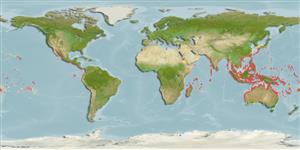Common names from other countries
Classification / Names / Names
Common names | Synonyms | Catalog of Fishes (gen., sp.) | ITIS | CoL | WoRMS
Malacostraca >
Decapoda (Lobster, shrimp and crabs) >
Ocypodidae (fiddler and ghost crabs)
Environment: milieu / climate zone / depth range / distribution range
Ecology
Benthic. Tropical
Indo-Pacific: from East Africa to the Philippines and the Great Barrier Reef.
Length at first maturity / Size / Weight / Age
Maturity: Lm ? range ? - ? cm
Inhabits sandy beaches (Ref. 3477). Appears to be a predator in beaches where it is abundant (Ref. 111610). Burrows are obvious during summer but hardly seen during winter (Ref. 125338).
Life cycle and mating behavior
Maturity | Reproduction | Spawning | Eggs | Fecundity | Larvae
Members of the order Decapoda are mostly gonochoric. Mating behavior: Precopulatory courtship ritual is common (through olfactory and tactile cues); usually indirect sperm transfer.
Gibbs, P.E. 1978. (Ref. 3197)
IUCN Red List Status (Ref. 130435)
CITES status (Ref. 108899)
Not Evaluated
Not Evaluated
Human uses
| FishSource |
Tools
Internet sources
Estimates based on models
Preferred temperature
(Ref.
115969): 27.3 - 29.3, mean 28.6 (based on 1349 cells).
Price category
Unknown.
